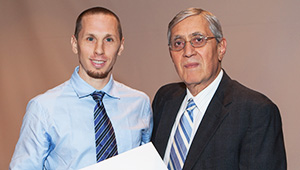

Netting Success
Dr. Brian Scharf: Netting Success in Science
Winning a pro tennis match requires the same approach it takes to excel in science.
"They both take non-stop focus," said Dr. Brian Scharf, a pathology postdoctoral research fellow in the laboratory of Dr. Laura Santambrogio, and a former professional tennis player.

Brian Scharf, Ph.D.Though he traded a career on the courts for a bench in a laboratory, after only one year as a fellow, his hard work has paid off.
On November 13, 2012, Dr. Scharf was among three Einstein postdoctoral fellows selected annually to receive the prestigious Dennis Shields Prize for Outstanding Research.
For the pathology researcher, the $5,000 prize - awarded in memory of the internationally recognized cellular biologist who died in 2008 - was "icing on the cake." The award came on the heels of another milestone in his still young career: being first author on a published paper that was based on three years of research to characterize how the body's immune system responds to exposure to biomaterials, such as stents and implants.
The paper, titled "Annexin A2 binds to endosomes following organelle destabilization by particulate wear debris," appeared in the March 2012 issue of Nature Communications. "It was the first article describing the role of Annexin A2 in repairing membrane damage," explained Dr. Scharf.
Impressed by his specialized skill set, Dr Santambrogio, professor of pathology and of microbiology & immunology, hired Dr. Scharf in 2008 through a two-year neuropathology training grant.
"Brian has a unique expertise in electron microscopy (EM), and he developed a new EM imaging technique in the laboratory that has been utilized by other postdocs," she said. "I'm obviously very proud."

Dr. Scharf receiving his prize from Einstein Dean Allen M. Spiegel, M.D.Dr. Scharf gained his experience in electron microscopy at St. John's University, in Queens, where he received his Ph.D. in environmental toxicology. Working under the guidance of professor Louis Trombetta, he examined the toxicity and bioaccumulation of a widely marketed copper-based wood preservative copper dimethyldithiocarbamate (CDDC).
"CDDC was allowed to be put up for sale without testing to see how fast it leeched out," Dr. Scharf said, noting the preservative was readily found in park benches, playgrounds, and porch decks, among other products.
Since there were no prior published toxicological studies of CDDC, a key success in this work was delineating its toxicity and its mechanism of action in multiple organ systems by using a series of biochemical, analytical, and ultrastructural techniques. The findings led to two first-author opportunities for the fledgling researcher and three presentations at annual Society of Toxicology conferences.
"My training as a toxicologist - learning to investigate, interpret, and communicate the nature of toxic effects - helped me on my initial project at Einstein," said Dr Scharf.
He studied the molecular basis of the immune response to particles that result from the wearing down of implanted devices and related ailments caused by this process, which represent a major complication of hip and knee replacements. His current projects include investigating immunological reactions of implanted devices and the biochemical analysis of structural proteins in aging cartilage.
As an athlete, Dr. Scharf knows first-hand how important it is to be able to move with ease. Growing up in Yonkers, Brian and his fraternal twin brother, Erik, played tennis and were attracted to science.

Scharf’s twin brother, Erik, with tennis champion Roger Federer"Erik was a highly competitive and accomplished gymnast, whereas the same could be said about my running prowess. We decided at the age of 14 to dedicate our focus solely on tennis," said Dr. Scharf.
When it came time for college, he turned down full academic scholarships from West Point and Cornell - and a partial academic scholarship from Columbia - for the full athletic scholarship at St. John's.
Meanwhile, Erik turned down athletic scholarships from Duke, UCLA, and Pepperdine, among others, and followed his brother to Queens, where both played competitive tennis.
In 2002, Dr. Scharf played for one year on the pro tennis circuit, but ultimately traded the grueling - and surprisingly unglamorous lifestyle - for the rigors of science.
"It's a really tough grind; fans don't see all the cutthroat stuff going on behind the scenes," he said, of life on the court.
Meanwhile, Erik, a high performance tennis coach at the John McEnroe Tennis Academy, and an exercise physiologist, went on to play pro tennis for seven years. He had several wins over players ranked in the top 200. He also was Roger Federer's practice partner for the 2008 U.S. Open, in which Federer defeated Andy Murray in the finals that year.
These days, when Dr. Scharf's not in the lab, the "weekend warrior" spends time running or hitting a tennis ball with his twin. "We always joke we have a lifetime practice partner," he said. The two live together in Yonkers.
Looking forward, he hopes to work in government or remain in academia, but is sure to continue his career in science. "It's a field in which you can ask a lot of questions and try to find the answers," he said. "That's the thrill of it."
Posted on: Wednesday, March 6, 2013

Tablet Blog